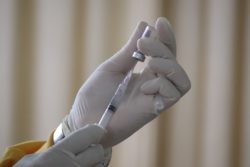In addition to the adverse event of dizziness reported during and post Lupron use, just reading and trying to understand Lupron’s literature can also be dizzying. So much of the research and information about this drug is utterly baffling; some circumstances have been manipulated by slick design, with information hidden or suppressed, other Lupron information can be readily disproved by known facts, and all this is admixed with conflicts of interest. In the process, decades of victims have accumulated and are without any real medical or legal advocacy. All the while, the powers that be have essentially appeared inert.
The contradictions found within Lupron documentation are indeed baffling and Lupron’s history is littered with instances of nefarious machinations. In prior installments of this series, the conflicting information about Lupron’s metabolism has been explored (part 4), as well as addressing the fact that Lupron is categorized as a hazardous, Pregnancy Category X drug (meaning it should be avoided by any woman who is or who may become pregnant), yet Lupron is prescribed to women in IVF, egg donation and surrogacy (part 3). Since there are numerous other examples of puzzling – just plain wacky (inexplicable and unacceptable) – ‘circumstances’ surrounding Lupron, this final installment will look at a number of these head-scratchers, as well as reviewing some of the more notorious slick maneuvers associated with Lupron. (The other installments in this series were Part 1, Part 2, and Part 5.)
Why has Lupron’s manufacturer made statements that can be proven inaccurate?
Oral Lupron: No — Yes — Maybe so?
Lupron’s labels and the literature ubiquitously proclaim that Lupron “is not active when given orally” – yet early investigation shows information to the contrary. None other than Andrew Schally, who is responsible for the isolation of the GnRH molecule (allowing the subsequent manufacturing of its analogs), and who won the 1977 Nobel Prize in Medicine for doing so, co-authored a 1975 article on the oral administration of Lupron. Thirteen healthy men were given Lupron (known only chemically, at the time, as “D-Leu-6 des-Gly-NH2-10”) by mouth, and within 45 minutes “the analogue had produced a statistically significant increase in mean plasma LH concentration”, and “the times of maximum LH activity noted … by mouth were not much different from those observed after parenteral injection”.
While the majority of men in this study did not have raised FSH concentrations, the remaining subjects had a significantly different mean change in plasma FSH concentrations “24 hours after the oral dose”. The article notes that “[a]lthough [Lupron] seemed to have little effect on FSH release, the interpretation depends upon how the results are expressed.” Discussion of Lupron’s parenteral effects decades later noted “the lack of long-term suppression of FSH observed in some patients” (American Hospital Formulary Service, Drug Information, 1994; p. 644). So it would appear that both oral and parenteral routes of Lupron have induced similar LH and FSH responses.
Andrew Schally stated 42 years ago that “oral administration [of Lupron] can now be added to the previously established effective methods [of intravenous, subcutaneous, and intramuscular administration].” Yet Lupron’s labels continue to state that it is “not active when given orally”.
Lupron Induces Menopause – NOT
In Lupron brochures for its use in endometriosis, the manufacturer states: “GnRH … acts on the pituitary to stimulate two other hormones, LH and FSH. … When LUPRON DEPOT is administered monthly, production of these hormones is reduced to the very low levels found after menopause” (emphasis mine). Yet, any medical textbook describes menopause as “FSH and LH (mainly FSH) are produced thereafter in large and continuous quantities” (emphasis mine) (‘Textbook of Medical Physiology’, A.C. Guyton. 1981. 6th Edition. W.B Saunders Co. Philadelphia; p. 1016).
And most astoundingly, the hormonal profile of a menopausal woman – increased FSH/LH, decreased estrogen (“hypergonadotropic hypogonadism”) does not match the hormonal profile of a woman on Lupron – decreased FSH/LH, decreased {sometimes} estrogen (“hypogonadotropic hypogonadism”). (See ‘Chart 1″ on page 2 here.) Yet women are repeatedly told Lupron will put them into a temporary “menopause”.
Endometriosis Clinical Trials’ Data versus Claim in Lupron’s Label
Lupron’s female labels state the drug’s hypoestrogenic effect “is reversible on discontinuation of therapy”. However, an independent analysis of the endometriosis clinical trials’ raw data conducted during a product liability litigation revealed “62.5% of study subjects had failed to return to baseline ovarian function one year after stopping Lupron.” (Issue discussed in further detail below.)
Lupron-induced Impotence
Initial 1980s clinical trials for FDA approval of Lupron for use in palliative treatment of prostate cancer found that 2 out of 98 subjects experienced the adverse event of impotence. More than a decade later, it was reported that Lupron “strongly suppresses erectile function and sexual activity” and “sexual desire, sexual interest and sexual intercourse were totally annulled.” Large scale studies have revealed “80%” of subjects using GnRHas reported being impotent, and a “267% increase in impotence was observed after one year of treatment”
A decrease in sex drive (reported by both sexes) and impotence are such well-known, expected, adverse effects of Lupron that the drug has for some time been used (court ordered at times) as ‘treatment’ for sex offenders (see here, here, and here).
It should be found curious that what has become accepted as a near-universal adverse event to Lupron (impotence) was claimed, in the initial clinical trials, to affect a mere “2 out of 98” subjects.
Infamous Fraudulent Marketing Schemes and Unlawful Off-label Promotion of Lupron
There is quite a history of Lupron being unlawfully promoted for off-label indications, including the company receiving “Notices of Adverse Findings” from the FDA about the company’s Lupron symposiums (deemed ‘indoctrinations‘ by the FDA).
In 2001, Lupron’s manufacturer paid $875 million, the then-highest criminal and civil fine in U.S. history, for its fraudulent marketing scheme to promote sales of Lupron, involving violations of the False Claims Act, 31 U.S.C. §§ 3729. The landmark case highlighted the company’s monetary incentive schemes to physicians to boost Lupron sales. Internal confidential company memos detailed how urologists could earn $105,011.40 annually by prescribing Lupron to just 65 patients. The U.S. government’s investigation revealed that the company provided many sales incentives, such as products, cash prizes, and trips, including a vacation referred to as the “Excalibur” – and the “Excalibur party was awarded annually to the top 30% of the [] sales force. … At times in the 1990s, the annual budget for the Excalibur party exceeded $4,000,000” (see page 9 here).
More recent ideation can be gleaned from anonymous postings in a pharmaceutical ‘sales rep chat room’; i.e., a few noteworthy 2010 posts state: “ABBOTT PAYS MILLIONS UNDER THE TABLE SO DOCS USE LUPRON” (emphasis in original) (posted 3/27/10 @ 7:45 PM); and “the docs know who has buttered their bread, and we [Abbott] got very deep pockets” (posted 3/27/10 @ 9:41 AM)
Why was the preservative in daily Lupron given only to humans, and not given to the “study rats”?
The daily formulation of Lupron is prescribed to both the pediatric and adult population, and was the very first FDA approval Lupron received, in 1985. This initial, approved formulation contains the preservative “benzyl alcohol”. But curiously, the animal toxicology studies required for Lupron’s initial FDA approval were not done using Lupron and benzyl alcohol, but were done using Lupron and “normal saline” (NDA 19-010). Shouldn’t these animal toxicology studies reflect the exact injection intended for humans?
The National Institute for Occupational Safety and Health (NIOSH) lists pages of toxicity data for benzyl alcohol, while the Material Safety Data Sheet (MSDS) for benzyl alcohol identifies that there is “no information available” for numerous areas (such as teratogenicity, neurotoxicity, reproductive effects – See ‘Section 11’ here). Why were rats spared the exposure to benzyl alcohol in their Lupron injections, when humans were and are exposed to the benzyl alcohol day after day in their daily Lupron injections?
Funny Business with Bones
In this discussion, it is important to note that human bones contain 2 different types of bone – cortical (or compact) bone and trabecular (or cancellous or spongy) bone (see here and here).
While there are studies which claim no adverse effect of Lupron/GnRHas on the bones of treated children (i.e., here), other published reports on treated children note leuprolide/GnRHas “may have an adverse effect upon bone health“. As early as 1991, “a small but significant decrease in bone mass” was noted in a small Italian study using another GnRH analog (triptorelin) in children with precocious puberty. Another small Italian study in 1995 using leuprolide to treat precocious puberty found a “reduction of trabecular bone mass”. In a small Taiwanese follow-up study of girls treated with either leuprolide or triptorelin, “45% of patients had lumbar bone mineral density less than 1 SD below that of normal young Taipei adults”, evidencing “45% of patients had decreased bone accretion during therapy“. And recently a small study in Turkey using leuprolide in children concluded “GnRHas may have an adverse effect on bone health” perhaps via an impact upon vitamin D levels.
As early as 1991, in gynecological uses of GnRHas, evidence indicated that there was little or no change in cortical bone density, however “[t]he great majority of studies of trabecular bone show a significant reduction in bone mass in both spine and distal radius during 6 months of agonist therapy … between 5-10% of baseline”. Another early study in treatment of endometriosis found “bone loss induced by GnRH analogs may be associated with adverse effects on cancellous [trabecular] microstructure which are unlikely to be reversed following cessation of therapy.” (An increased rate of bone loss in men receiving Lupron and other GnRHas has also been reported, i.e. here.)
It is important to note that most of the bone mineral testing done using Lupron or other GnRHas in adults have been done using DEXA (Dual-energy X-ray absorptiometry) or DPA (Dual-photon absorptiometry) scans; and there have been GnRHa studies using DEXA in precocious puberty bone mineral density assessments. Another study, using triptorelin in precocious puberty subjects, evaluated bone mineral density by assessment with DEXA and concluded that while bone mineral density was significantly lower at discontinuation of GnRHa, later DEXA scans showed values “not significantly different from controls.” (But what would QCT [quantitated computerized tomography] scans have revealed?)
Bone density scans such as DEXA/DXA and DPA assess both cortical and trabecular bone – and studies using DEXA and DPA scans have revealed adverse effects from GnRHas (i.e. bone mineral density “decreased significantly [6 months: -6.0%, 12 months: -8.0%]”). However, QCT scans assess only trabecular bone and are most effective at detecting “the significant trabecular bone loss of the vertebrae and hip [associated] with GnRH agonists”. (See also here.)
GnRHas appear to have “a significant negative impact on trabecular bone mass. … Initial studies [in women] with dual-photon absorptiometry [DPA] were unable to detect any appreciable bone loss with GnRH agonists. … Quantitated computerized tomography [QCT] always shows significant trabecular bone loss of the vertebrae and hip with GnRH agonists. Depot preparations appear to produce more marked loss than daily intranasal sprays.” (emphasis mine).
Early investigations of leuprolide and buserelin’s effect upon cortical and trabecular bone mineral content in women with endometriosis identified that “[b]ecause QCT of the spine measures only the trabecular bone … any significant change affecting mainly the trabecular bone is more readily detected earlier by the QCT”, and “[b]ecause DPA measures both trabecular and cortical bone, a significant reduction in true trabecular bone mass actually may be diluted … thus giving a lack of significant change.”
In further illustration of this point, note that Lupron’s label for endometriosis from 1991 through 1996 stated “after 6 months the vertebral trabecular bone density as measured by QCT was decreased by an average of 13.5%”, however in 1996 Lupron’s endometriosis label was changed to read the “vertebral bone density as measured by DEXA was decreased by an average of 3.9%” (1991 – 1995 Physicians Desk Reference, Lupron Depot 3.75 mg). By using data only from DEXA scans, the significant bone density loss previously detected by QCT was eliminated. Current Lupron Depot 3.75 mg label states “vertebral bone density as measured by dual energy x-ray absorptiometry (DEXA) decreased by an average of 3.2%”. By continuing to use data only from DEXA scans, the “significant” bone density loss detectable by QCT is ensured to remain undetected.
In a 2000 study of bone markers and bone mineral density during growth hormone treatment in children with growth hormone deficiency, it was noted that future research should be carried out “by the direct measurement of bone density using quantitative computer tomography [QCT]. Mineralization is only one facet of bone strength, however; other important components (e.g. bone structure and geometry) should be addressed in future paediatric studies.” (See also here.) A PubMed literature search of ‘QCT bone pediatric GnRHa’ produced zero results for humans, but one result was found for a report on rats (in which bone mineral density was “significantly decreased in GnRHa-treated rats” and concluded “a delay in the onset of sexual maturation may cause prolonged, possibly irreversible defect in bone mineralization”).
In a 1995 study, bone biopsies and microscopic analyses (histomorphometric analysis) were done on women treated with GnRHas and the “results suggest that bone loss induced by GnRH analogs may be associated with adverse effects on cancellous [trabecular] microstructure which are unlikely to be reversed following cessation of therapy.” Microscopic scan photographs of a 28 year old woman treated with GnRHa for 6 months show “severe disruption of the cancellous microstructure in the post-treatment biopsy” – see photo on page 6 here.
It would appear that without a body of data specific for QCT results, appropriate conclusions cannot be reached about the effects of GnRHas upon the type of bone (trabecular) that is most impacted by GnRHas. All the above points to the need to assess Lupron/GnRHas effect upon trabecular bone through QCT scans – and it would seem that to do otherwise would hinder data collection.
Yet many Lupron studies and follow-up studies have been designed using non-QCT bone density scans, and often it is wrist (and not hip or vertebral) scans that are performed. A perverse analogy comes to mind, relating to the heinous act of sick individuals who hide dangerous items (i.e., needles, razor blades) into the center of Halloween candy – and the community safeguards that have been enacted to X-Ray the candy in order to assess and ensure safety (i.e., here and here): What if these community resources were not offering to X-Ray the candy but instead were offering to merely photograph the candy in attempts to ‘assess and ensure safety’?
Tricks in the Courtroom Yield Treats for Lupron’s Manufacturer
The only lawsuit to make it to trial (in 2011), the case of Karin Klein v. TAP, Abbott, stemmed from Karin’s prescription of Lupron Depot 3.75 mg in 2005 as a 17 year old for endometriosis – and resulted in the development of (among others) a thyroid disorder. Pre-2005 Lupron Depot 3.75 mg labels, and post-2005 Lupron Depot 3.75 mg labels (domestic and foreign), warned of thyroid adverse events, but the company removed this warning for the 2005 label – the year of Karin’s prescription.
At trial, Karin was prevented from presenting to the jury any pre-2005 or post-2005 Lupron Depot 3.75 mg labels acknowledging thyroid adverse events, and the trial judge only allowed the jury to consider the 2005 label which lacked the warning. Lupron manufacturer’s principal medical expert, Dr. Richard Blackwell, under oath falsely stated “the thyroid gland … There are no receptors for GnRH. So there is no basic key on the thyroid gland for Lupron. Therefore, it is absolutely biologically impossible for Lupron to affect the thyroid gland. No textbook, no article has ever supported that contention. It’s simply biologically impossible” (emphasis mine) – see page 20 here.
Of note, Dr. Richard Blackwell has a history of receiving monies to study Lupron in women – see ‘Birmingham Center’ in this ‘Multicenter Lupron Study Group’. Also note that the latter study’s lead investigator, Dr. Andrew Friedman, was found guilty of fabricating and falsifying approximately 80% of data in 4 Lupron studies.
When the Klein jury heard Lupron’s expert medical witness proclaim it was “biologically impossible” for Lupron to affect the thyroid gland, they could not possibly know this physician was committing perjury. (Perjury is a felony, and if convicted involves fines and/or imprisonment up to 5 years – see here and here). If only the jury had known that evidence of this misinformation was just a keyboard away – a simple PubMed search (up to, and including, 2005) reveals the following published medical journal articles that evidence it is absolutely biologically possible for Lupron to affect the thyroid gland’:
“The first report to demonstrate the association of thyroid disorder with leuprolide [Lupron] injections” (2000), “Possible induction of Grave’s disease & painless thyroiditis by GnRHa’s” (2003), “The role of leuprolide acetate therapy in triggering auto-immune thyroiditis” (2005).
Serving as an “expert”, this is information that must certainly have been known, yet as a ‘hired gun’ for the drug company, the existence of this information was emphatically denied – leading the jury to believe it was impossible for Lupron to cause Karin’s thyroid disorder, and resulted in the jury finding in favor of the drug company. And thus the queue of Lupron litigation that was forming in anticipation of a Klein victory suddenly evaporated in the face of unmitigated, unethical, unlawful, unseemly, unchallenged ‘expert’ machinations.
To quote a ‘friend of the court’ brief filed on behalf of Klein by the organization “Consumer Attorneys of California”:
“[Klein was] entirely shackled in the evidence she was allowed to present. It is particularly galling to have qualified (and expensive) expert witnesses on hand to testify [on behalf of Klein], only for them to be shut down before the jury and precluded from offering competing expert opinions. The pattern shown by the record is deeply disturbing. Virtually every discovery and evidentiary ruling, and other orders of significance, went for one party [Lupron’s manufacturer]. Klein was not entitled to a perfect trial, but at least an evenhanded one. Such a one-sided proceeding was not the fair trial our system demands” (emphasis mine) – see page 6 here.
Klein ultimately petitioned the U.S. Supreme Court which refused to hear the case – great news for Lupron’s manufacturer, terrible news for young, disabled Klein, and chilling repercussions for society at large and Lupron victims in particular. Apparently, perjury under oath by paid medical experts, grossly misleading a jury, and the denial of a right to fair trial are issues deemed not significant by the U.S. Supreme Court. For further information on the Klein matter, see here, here and here.
Obscuring the Drug’s Hazardous Status
Lupron is categorized by the FDA as a “Pregnancy Category X drug” (page 20, “leuprolide” – meaning any woman who is or who may become pregnant should avoid exposure), yet it became a staple of ovulation induction medication regimens in infertility, egg donation, and surrogacy. Lupron’s labels do state there is “a potential hazard to a fetus” (and oddly the most wording is found within the male Lupron Depot label). Lupron is classified by the National Institute for Occupational Safety and Health (NIOSH) as a “hazardous drug” (page 20, “leuprolide”), however nowhere in any of Lupron’s labels is there identification that Lupron is classified as a “hazardous drug” (i.e., pediatric, female, male); nor does the label advise that as a result of this classification by NIOSH, special requirements apply for the handling, preparation, and administration of “hazardous drugs” (see here and here).
Around 2008, curious changes took place within Lupron labels (multiple indications) whereby it appears that cleverly, as if hiding evidence in plain sight, the “References” section of the labels now contained 4 citations – yet there are no corresponding footnotes within the label’s text for any one of these 4 citations. These 4 new “References” are as follows: (#1) NIOSH Alert, Preventing occupational exposures to antineoplastic and other hazardous drugs in healthcare settings; 2004. U.S. Department of Health and Human Services, Public Health Service, Centers for Disease Control and Prevention, NIOSH Publication No. 2004-165; (#2) 1999 OSHA Technical Manual on Hazardous Drugs; (#3) 2006 ASHP guidelines on hazardous drugs; and (#4) 2005 Oncology Nursing guidelines on hazardous drugs (see pages 6, 14, 25, 36, and 47). Again, most curiously, not one of these 4 citations/”References” — or the information the citation source contains — were referred to, mentioned, identified, or discussed, at all, within the Lupron labels.
And presently, revised labels no longer contain the 4 citations mentioned above (see pediatric, female, male); and the labels continue to omit any identification of Lupron as a “hazardous drug”.
Measures Undertaken to Silence Critics
The Cardiac Stent Internal Memo
When Lupron’s manufacturer was under investigation for potential fraud related to its cardiac stents, numerous critical articles were written by a Baltimore Sun news columnist – and the drug company apparently targeted this columnist. As reported in a 2010 Senate Committee on Finance (examining a “clear example of potential fraud, waste and abuse”), “one Abbott official suggested that local connections or the “Philly mob” should intervene to silence Baltimore Sun columnist Jay Hancock for his coverage of the scandal, saying “someone needs to take this writer outside and kick his ass!”
Not a ‘seal of approval’ – the Hidden Lupron Endometriosis Clinical Trials’ Data
To the best of my knowledge, no one other than Dr. Redwine has independently analyzed the thousands of pages of raw data from the 1980s clinical trials for Lupron’s initial use in adult females (Lupron Depot 3.75 mg, for endometriosis). The conclusion from this independent analysis was that fraudulent data and misleading outcomes were found within these trials’ raw data. In one example, the raw data showed that “62.5%” of subjects had failed to return to baseline ovarian function one year after stop of study – yet Lupron’s label states Lupron’s hypoestrogenic effect “is reversible on discontinuation of drug therapy.” (For further information, see Part 3 of this series; the FDA’s response to Dr. Redwine’s request for an investigation into this serious matter; and here.)
It certainty appears that Lupron’s manufacturer intends to keep this raw data hidden from public view. Years ago the company sought and obtained a court-ordered seal on the raw data from these endometriosis clinical trials (see page 6 here), ensuring that this data will remain concealed from the public and any inquiring eyes.
Several years ago, when my assistance was sought by a Lupron victim whose attorney had retired in the middle of her case, the opportunity was used to file a motion to request the Court remove this seal (see “Reply Motion … and a Request that Court Seal on Defendants’ Clinical Trial Data Be Lifted”, Document # 135, Case 1:11-cv-04860, filed 2-20-14, Paulsen v. Abbott, Takeda, TAP, US District Court, Northern District of Illinois, Eastern Division). No response from the Court was ever forthcoming from this request to unseal the raw data. The Paulsen case remains pending (see also here). A request to Lupron’s manufacturer to lift their seal also was unsuccessful (personal correspondence, 2015).
Suppression of Lupron’s Risks in Physician Continuing Medical Education
Renowned endometriosis surgeon Dr. Redwine became an outspoken critic of the use of Lupron in gynecology, and his opinion was reinforced by more than 700 women in his surgical practice who relayed harm from prior Lupron exposure. Dr. Redwine had most honorably refused the Lupron sales representative’s offer of $100,000 if he would prescribe Lupron to his patients. In 1994, Dr. Redwine wrote a ‘letter to editor’ in a fertility journal stating
“Inclusion of patients with a poor response to GnRHa therapy has not always occurred in outcome analysis in the published medical literature” (Letters: Pros and Cons of “Add-Back” Therapy. 1994. Fertility and Sterility, 61:2:404).
According to Dr. Redwine’s expert medical testimony in the Klein case (in which he describes Lupron as being “unsafe and harmful in addition to being ineffective”), the following incident from the 1990s is described: Dr. Redwine was scheduled to be a speaker at a continuing medical education forum but was prevented from doing so by Lupron’s manufacturer because of his opposition to the use of Lupron. The drug manufacturer “interfered in the continuing medical education of physicians in order to enhance the sales of Lupron Depot” (see other excerpts of Dr. Redwine’s testimony here).
Peculiar Omission of Lupron/GnRHa Data in Studies of Health Disorders in Women With Endometriosis
Bone Density Loss
In 1989, a leading Lupron/GnRHa investigator in precocious puberty and gynecology concluded in a study that reduced bone mass (“significantly decreased cortical and trabecular bone mass”) was associated with the disease endometriosis. However, another study which found contrasting findings reported that “women with endometriosis do not have reduced bone density … One explanation for the difference between the results of this study and those of Comite et al. is that they included women who previously had been treated with GnRH agonists and these agonists are associated with bone loss.” (For further elaboration on these studies, see here.)
In my opinion, claims that the disease of endometriosis is associated with bone density loss, while appearing to deliberately omit the endometriosis patients’ common history of prior use of Lupron (which is known to causes bone density loss), is a treacherous concept and a slick maneuver — seeming to shield and manipulate iatrogenic, adverse drug effects into an ‘endometriosis-disease-related’ (and non-tort) phenomenon. This is something that deserves attention.
Autoimmune and Endocrine Disorders, Fibromyalgia, Chronic Fatigue Syndrome and Atopic Diseases
A 2002 publication (“High rates of autoimmune and endocrine disorders, fibromyalgia, chronic fatigue syndrome and atopic diseases among women with endometriosis: a survey analysis”) also failed to make any mention of Lupron or other GnRHas as treatment for endometriosis. This survey analysis, co-authored by the President of the Endometriosis Association (which has received hundreds of thousands of dollars from Lupron and other GnRHa manufacturers) also failed to identify the reported adverse events to Lupron (the most commonly prescribed medical therapy for endometriosis) – which have included autoimmune and endocrine disorders, fibromyalgia-like syndrome, chronic fatigue syndrome, and atopic diseases.
Yet, the survey upon which this analysis drew its conclusion does contain reference to Lupron/GnRHa use in the survey participants. In fact, of the 4000 surveys tabulated, 59% of survey respondents reported a history of Lupron/GnRHa use (‘Key Results from North American Membership Survey’, Endometriosis Association, 1998. Presented at VI World Congress on Endometriosis). Given that the majority of the endometriosis respondents reported a history of Lupron/GnRHa use, how could this fact and highly significant confounding factor be ignored?
In my opinion, claims that the disease of endometriosis is associated with autoimmune and endocrine disorders, fibromyalgia, chronic fatigue syndrome and atopic diseases, while appearing to deliberately omit the endometriosis patients’ common history of prior use of Lupron (which is known to cause autoimmune and endocrine disorders, fibromyalgia-like symptoms, chronic fatigue syndrome and atopic diseases), is a treacherous concept and a slick maneuver — seeming to shield and manipulate iatrogenic, adverse drug effects into an ‘endometriosis-disease-related’ (and non-tort) phenomenon. This is something that deserves attention.
Coronary Heart Disease
Upon initial FDA approval for men in 1985, Lupron was alleged to have ‘insignificant cardiac adverse events’. (For further details on cardiac adverse events provided to and withheld from FDA by the manufacturer prior to approval, see page 4 here.) Subsequently, Lupron became the most prescribed GnRH analog. Decades later, a large study would show that the use of Lupron (and other GnRH analogs) for androgen deprivation therapy in management of prostate cancer was associated with a “10 – 50% increase” in the risks of coronary heart disease, myocardial infarction and sudden cardiac death (as well as fractures, strokes, and diabetes).
As a result of this and similar studies, the FDA issued a warning in 2010 concerning an increased risk of developing cardiovascular problems in men prescribed Lupron/GnRHas. The FDA acknowledged that there are no studies evaluating the cardiovascular risks of Lupron/GnRHas in children or women. (To the best of my knowledge, there remains today no studies looking at Lupron/GnRHas cardiovascular risks in pediatric or female use; however there is presently an FDA “specific review” of nervous system and psychiatric events in children, and the NIH is in the midst of a study of long-term outcomes in transgender youth’s use of Lupron/GnRHas, evaluating “physiological and psychosocial impact, as well as safety”.)
In 2016, a cardiology journal published a study based on survey responses from the large-scale ‘Nurses’ Health Study II’ database, and this study associated endometriosis with an increased risk of coronary heart disease. Can you guess which drug was not queried in this ‘Nurses’ Health Study II’ survey? This survey sought information on the woman’s use of alcohol, cigarettes, post-menopausal hormones, oral contraceptives, multivitamins, analgesics (including acetaminophen, aspirin, ibuprofen, indometacin, naproxen, nabumetone, ketoprofen, celecoxib, rofecoxib, and valdecoxib), but omitted any questions about the woman’s exposure to the most frequently prescribed treatment for endometriosis – Lupron/GnRHas.
My response to this inexcusable omission of Lupron/GnRHa exposure data was published in the journal – see “Article’s conclusions seriously flawed without data on Lupron/GnRHa use”. The authors of the study responded with inaccurate information on Lupron (see May 11, 2016 response), prompting me to submit a reply addressing this incorrect information. The journal failed to publish this corrective information, therefore I’ve published my reply on my own website.
In my opinion, claims that the disease of endometriosis is associated with coronary heart disease, while appearing to deliberately omit the endometriosis patients’ common history of prior use of Lupron (which is known to cause numerous cardiovascular adverse effects in women – see ‘Cardiovascular Effects’, Left column here; and here), is a treacherous concept and a slick maneuver — seeming to shield and manipulate iatrogenic, adverse drug effects into an ‘endometriosis-disease-related’ (and non-tort) phenomenon. This trend is very troubling, and is something that deserves significant attention and investigation.
Conclusions
The above information, as well as information found within this series, the Kaiser Report, and other media sources (see here) should be more than sufficient indication that numerous investigations into the effects of Lupron (and all GnRHas) are warranted.
That there are large numbers of Lupron victims cannot be disputed – one need only have computer access to verify this sad fact. (For links to a large sampling of Lupron reviews, stories, posts and comments in various medication and legal websites, see here.) The petitions to Congress requesting an investigation into Lupron appear to have fallen on deaf ears; one petition started in 2009 states more than 21,000 messages have been sent to date. (Links to multiple petitions, in the U.S. and France, containing more Lupron horror stories, can be found here.) There are more than ample numbers of Lupron victims complaining, the problem has been identified – what is needed is action.
Investigative reporters, the FDA, Congress, public health authorities, and the medical and legal community need to do their job and focus multiple spotlights on all the aspects of this drug, its effects, its associated harms, and the lack of medicolegal advocacy for its victims.
In my opinion, this drug should have been withdrawn from the market a long time ago – just how many more victims will it take?
Someone needs to be held responsible for all the suffering, and the ruined health, and careers, and lives of so many Lupron victims and their families. The devastation that Lupron has wrought ought to be criminal. People need to go to jail.
Or perhaps, they should just get a Lupron injection themselves.
Share your Story
If you have a Lupron story, please consider sharing it on Hormones Matter.
We Need Your Help
More people than ever are reading Hormones Matter, a testament to the need for independent voices in health and medicine. We are not funded and accept limited advertising. Unlike many health sites, we don’t force you to purchase a subscription. We believe health information should be open to all. If you read Hormones Matter, like it, please help support it. Contribute now.
Yes, I would like to support Hormones Matter.
This article was published originally on May 31, 2017.
Image by Peter Timmerhues from Pixabay.







